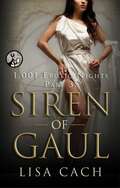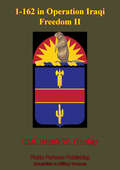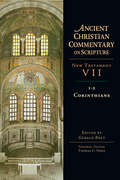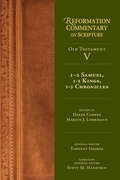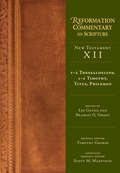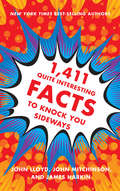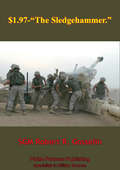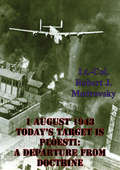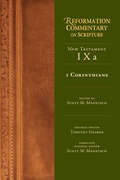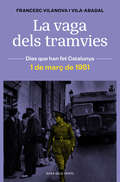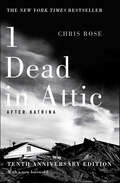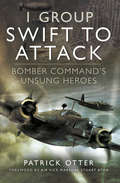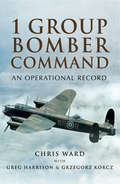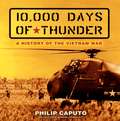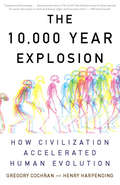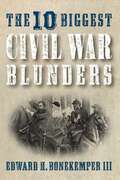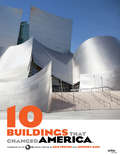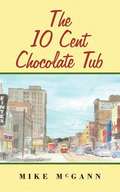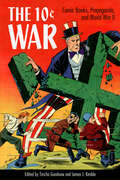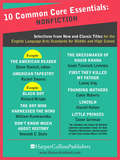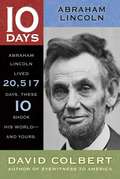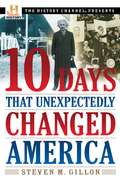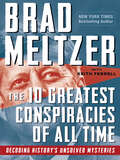- Table View
- List View
1,001 Erotic Nights, Part 3: Siren of Gaul (The 1,001 Erotic Nights Series #3)
by Lisa CachNational bestselling author Lisa Cach continues the erotic, passionate story of a young Roman Empire slave with a prophetic gift, whose sexual adventures lead her to love, heartache, power, and loss...ever hoping for true love.Beautiful Nimia is sent by the King of Gaul to the court of King Alaric II, to seduce him into handing over Sygarius--her first master, who had cruelly betrayed her, and to whom Alaric has given sanctuary. She is also there as a spy to gain information to help conquer Alaric's kingdom. Intelligent, devoutly religious, and sexually inhibited, Alaric presents Nimia with a fresh challenge. She must use the most subtle of her erotic skills to seduce him, only to find herself being seduced as well...and possibly falling in love? When Sygarius is handed over to her, Nimia finds herself torn between vengeance and forgiveness--and reluctant to leave Alaric, who just might be the love of her life....
1-162 In Operation Iraqi Freedom II (Eyewitness To Modern War #5)
by CSM Brunk W. ConleyThis is a paper concerning the federal activation of the 2-162 IN battalion out of Oregon, their mobilization experience, deployment to Iraq in support of Operation Iraqi Freedom II, the redeployment back to Conus and Oregon, and the repercussions of the mission on the Soldiers as they reintegrated back into their families, jobs, and society.
1-2 Corinthians: New Testament (Ancient Christian Commentary on Scripture #7)
by Thomas C. Oden Gerald BrayPaul's letters to the Corinthian church have left a mark on Christian Scripture in a way that could never have been predicted. Here the pastoral issues of a first-century Christian community in what Chrysostom identified as "still the first city in Greece" stand out in bold relief. How was a community shaped by the cross to find its expression in a city that Chrysostom knew to be "full of orators and philosophers" and that "prided itself . . . above all on its great wealth"? How was church unity to be maintained in a setting where prominent believers, bending truth and morality to their own advantage, divided the body of Christ? Here lay the challenge for the apostle Paul. And as the apostle writes, the fathers lean over his shoulder, marveling and commenting on his pastoral wisdom. Best known among these patristic commentators is Chrysostom, whose seventy-seven homilies on the two Corinthian epistles are a treasury of exposition and application. The fragmentary works of Didymus the Blind and Severian of Gabala give us samples of Greek exegesis from the Alexandrian and Antiochene schools. The partial work of Theodore of Mopsuestia, a commentator of great skill and insight, was long valued in the church. And the comments of Theodoret of Cyrus are notable for their sensitivity to the intertextuality of Scripture. Then there are Origen and Pelagius, whose names resonate with notable error, to the needless obscuring of their brilliant insights into Scripture. But pride of place goes to the unknown fourth-century commentator long mistaken for Ambrose and now dubbed "Ambrosiaster." His excellent commentary on 1 and 2 Corinthians has been unavailable in English translation, and for that reason it is excerpted more generously in this volume. This Ancient Christian Commentary on 1-2 Corinthians opens a whole new way of reading these New Testament texts. The pastoral and theological interpretation of the fathers offers spiritual and intellectual sustenance to those who would read Paul again with open minds and hearts. Here we find the Pauline wisdom of the cross generating an effective heritage of Christian interpretation.
1-2 Samuel, 1-2 Kings, 1-2 Chronicles (Reformation Commentary on Scripture Series #5)
by Derek Cooper"Then David said to the Philistine, 'You come to me with a sword and with a spear and with a javelin, but I come to you in the name of the LORD of hosts.'" (1 Samuel 17:45) Reflecting upon David's victory over Goliath, Reformation translator, theologian and commentator William Tyndale compared it to Christ's victory over sin and death: "When David had killed Goliath the giant, glad tidings came to the Israelites that their fearful and cruel enemy was dead and that they were delivered out of all danger. For this gladness, they sang, danced and were joyful. In like manner, the good news or 'gospel' of God is joyful tidings." The books of 1-2 Samuel, 1-2 Kings and 1-2 Chronicles, which record the history of Israel from the prophetic ministry of Samuel to the fall of Jerusalem, provided the reformers with some of the best-known narratives of the Old Testament upon which to comment, including Hannah's prayer, the anointing of Saul as Israel's first king, David's triumph over Goliath and his later adultery with Bathsheba, Solomon's building of the Temple, Elijah's challenge to the prophets of Baal, and the healing of Naaman. For the reformers, these stories were not merely ancient Israelite history, but they also foreshadowed the coming of Jesus Christ, and they had immediate relevance for their lives and the church of their day. Thus, Anglican exegete John Mayer perceived within King Josiah's reform of Israelite worship after the discovery of the Book of the Law a prefiguration of "what should be done in the latter days of the gospel, in which a greater reformation of the religion is now being made." In this Reformation Commentary on Scripture volume, Derek Cooper and Martin Lohrmann guide readers through a diversity of Reformation commentary on these historical books. Here, readers will find reflections from both well-known voices and lesser-known figures from a variety of confessional traditions—Lutherans, Reformed, Radicals, Anglicans and Roman Catholics—many of which appear in English for the first time. By drawing upon a variety of resources—including commentaries, sermons, treatises and confessions—this volume will enable scholars and students to understand better the depth and breadth of Reformation-era insights on Scripture. It will also provide resources for contemporary preachers, and encourage all those who continually seek to share the "joyful tidings" of Jesus Christ.
1-2 Thessalonians, 1-2 Timothy, Titus, Philemon (Reformation Commentary on Scripture #Nt Volume 12)
by Bradley G. Green Lee Gatiss"Since we believe that Jesus died and rose again, even so, through Jesus, God will bring with him those who have fallen asleep." (1 Thess 4:14).
1,411 Quite Interesting Facts
by John Lloyd John Mitchinson James Harkin1,411 Quite Interesting Facts to Knock You Sideways is a gold mine of wide-ranging, eye-opening, brain-bursting nuggets of trivia that's impossible to put down, another "treasure trove of factoids" (National Public Radio, Weekend Edition). Did you know?Orchids can get jet lagLizards can't walk and breathe at the same timeFrank Sinatra took a shower 12 times a dayLadybug orgasms last for 30 minutesThere are 177,147 ways to tie a tieTraffic lights existed before carsThe soil in your garden is 2 million years old
$1.97-“The Sledgehammer.” (Eyewitness To Modern War #4)
by Msg Patrick W. Bean Sr.Master Sergeant Bean recounts his experiences during the first Gulf war as an artillery specialist in Operations Desert Shield and Desert Storm.Success of any war, conflict, or operations Soldiers must meet the enemy, defeat the enemy on the battlefield, and return home safely. Defending our nation during the Gulf War was the high point of my career. This accomplishment serves as a key to my successful military career. Writing this personal experience brought memories good and bad. Although we won the war aboard, a battle was lost in my family. The psychological toll of war deeply affected my family. My personal experience paper will highlight psychological factors I overcame during preparation for combat, combat operations and the psychological effects on my family.
1 August 1943 - Today's Target Is Ploesti: A Departure From Doctrine
by Lieutenant Colonel Robert J. ModrovskyThe focus of this paper will be on the 1 August 1943 bombing raid on the Ploesti oil field and refineries by an American task force composed of bombardment groups of the Eighth and Ninth Air Forces. The Ploesti raid stood apart from the rest of the war in the air. The idea for it, and the unusual tactics employed, came from the top; it generated from General Arnold's headquarters and was approved by President Roosevelt. Winston Churchill called Ploesti "the taproot of German might." It was not a part of any particular campaign, but was considered vital in itself. It was painstakingly planned and executed relatively quickly by the best-prepared and most experienced force available at the time. It was also fought with unparalleled bravery, the sole action of the war for which five Congressional Medals of Honor were awarded. The purpose in examining Ploesti is to first gain a complete understanding of the events leading to the planning for the raid, the raid itself, and finally the impact on the Germans in its aftermath. With this established, the intent is to assess the raid while keeping one fascinating question in mind - after building a doctrine for twenty years based on high altitude, daylight, precision bombing, why, in its first major bombing effort, did the United States "depart from doctrine" and conduct a low level bombing mission on Ploesti, the only low-level bombing mission conducted in the war?
1 Corinthians: New Testament Volume 9A (Reformation Commentary on Scripture Series #9a)
by Scott M. ManetschIn his first letter to the church in Corinth, Paul writes, "I delivered to you as of first importance what I also received: that Christ died for our sins in accordance with the Scriptures, that he was buried, that he was raised on the third day in accordance with the Scriptures" (1 Cor 15:3-4 ESV). Reflecting on Paul's summary of the gospel, sixteenth-century biblical commentator, theologian, and Lutheran pastor Tilemann Hesshus wrote, "The central tenet and foundation of our entire religion is that our Lord Jesus Christ died for our sins and rose again for our justification. All of our comfort, salvation and hope rest upon this foundation. From this is derived that greatest comfort concerning the resurrection of the dead and the future life of eternal glory." Throughout the church's history, Christians have turned to the epistles of the Apostle Paul in order to understand the essentials of the Christian faith, learn from the challenges faced by early Christians, and discern how to navigate the complexities of following Christ. Among those who gained wisdom from Paul were the Protestant Reformers, who found inspiration and instruction about how to lead the church of their day during a time of significant theological debate, ecclesiastical reform, and spiritual renewal. In this volume of the Reformation Commentary on Scripture, Scott Manetsch guides readers through a diversity of Reformation-era commentary on the first of Paul's letters to the Corinthians. Within this volume, readers will encounter familiar voices and discover lesser-known figures from a variety of theological traditions, including Lutherans, Reformed, Radicals, Anglicans, and Roman Catholics. Drawing on a variety of resources—including commentaries, sermons, treatises, and confessions—much of which appears here for the first time in English, it provides resources for contemporary preachers, enables scholars to better understand the depth and breadth of Reformation commentary, and helps all Christians cling to the things of first importance.
1 de març de 1951: la vaga dels tramvies
by Francesc VilanovaLa vaga dels tramvies, iniciada l’1 de març de 1951, constitueix sens dubte un dia que ha fet història i que ens ha forjat com a poble. L’1 de març de 1951, a Barcelona, milers de ciutadans es van negar a agafar els tramvies per protestar contra l’augment del preu dels bitllets. Com es podia combatre una vaga d’usuaris en plena dictadura? Les lleis franquistes prohibien un munt d’activitats, però no havien previst la possibilitat de castigar aquells que es neguessin a utilitzar un servei públic. Aquesta protesta popular, que denunciava la incompetència i la corrupció moral del poder, i la posterior vaga general van esdevenir una referència inexcusable per a la lluita contra la dictadura. I van ser el punt de partida per a deixar enrere la resignació i el fatalisme de la postguerra i la descoberta que valia la pena lluitar i plantar cara.
1 Dead in Attic: After Katrina
by Chris RoseWith a new foreword by the author—Chris Rose&’s New York Times bestselling collection: &“A gripping book about life&’s challenges in post-Katrina New Orleans…packed with heart, honesty, and wit&” (New Republic).Celebrated as a local classic and heaped with national praise, 1 Dead in Attic is a brilliant collection of columns by an award-winning Times-Picayune journalist chronicling the horrific damage and aftermath wrought by Hurricane Katrina in 2006. “Frank and compelling...vivid and invaluable” (Booklist), it is a roller coaster ride through a devastated American wasteland as it groans for rebirth. Full of the emotion, tragedy and even humor—which has made Chris Rose a favorite son and the voice of a lost city—these are the stories of the dead and the living, of survivors and believers, of destruction and recovery, and of hope and despair.With photographs by British photojournalist Charlie Varley, 1 Dead in Attic captures New Orleans caught between an old era and a new, New Orleans in its most desperate time, as it struggled out of floodwaters and willed itself back to life.
1 Group: Bomber Command’s Unsung Heroes
by Patrick OtterFollowing the recent unveiling of the monument to Bomber Command in London's Green Park, the publication of this lovingly crafted account of the exploits of oft-overlooked 1 Group is set to be a timely one. Patrick Otter combines an appropriate level of detail regarding operations, aircraft, bases and incidents, with accounts of human endurance and squadron fraternity, which works to create a thoroughly well researched account of the wartime proceedings of 1 Group which is rooted firmly in humanity. The book is heavily illustrated throughout with both images of aircraft and pilot profiles, supplementing the text perfectly and working further to humanize the accounts which the author relays, as well as satisfying the Aviation buffs curiosity for new and interesting images of aircraft in their wartime contexts. Although often considered a somewhat controversial operational unit, the bravery of the men who made up Bomber Command has never been in question. This book is further testament to that fact.
1 Group Bomber Command: An Operational Record
by Chris Ward Greg Harrison Grzegorz KorczA history of the British Royal Air Force&’s 1 Group Bomber Command during World War II. During the period immediately before the Second World War, the RAF modified its command structure to rationalize for rapid expansion. Bomber Command was divided into six operational groups, each flying the same type of aircraft, including Wellingtons, Sterlings, and Lancasters. Chris Ward presents us here with the history of 1 Group Bomber Command, having previously acquainted us with the histories of three, four, five, and six Groups in four highly acclaimed volumes, published by Pen and Sword. He continues with characteristic ease, quality of research, and narrative pace, to present us with an operational record of the group&’s activities during a particularly dramatic period of aviation history. The book contains individual squadron statistics, their commanding officers, stations, and aircraft losses. It provides an exhaustive reference for one of the RAF&’s most important operational groups.
1 Mississippi 2 Mississippi: A Mississippi Number Book
by Michael Shoulders1 Mississippi, 2 Mississippi is a fitting follow-up to its companion state alphabet book. This fun, colorful, and superbly informative book teaches children about numbers using recognizable places, events, and facts from their respective states. Numbers throughout the books are explained with simple rhyme for younger children and are accompanied by detailed expository text for older learners.
10,000 Days of Thunder: A History of the Vietnam War
by Philip CaputoIt was the war that lasted ten thousand days. The war that inspired scores of songs. The war that sparked dozens of riots. And in this stirring chronicle, Pulitzer Prize- winning journalist Philip Caputo writes about our country's most controversial war -- the Vietnam War -- for young readers. From the first stirrings of unrest in Vietnam under French colonial rule, to American intervention, to the battle at Hamburger Hill, to the Tet Offensive, to the fall of Saigon, 10,000 Days of Thunder explores the war that changed the lives of a generation of Americans and that still reverberates with us today. Included within 10,000 Days of Thunder are personal anecdotes from soldiers and civilians, as well as profiles and accounts of the actions of many historical luminaries, both American and Vietnamese, involved in the Vietnam War, such as Richard M. Nixon, General William C. Westmoreland, Ho Chi Minh, Joe Galloway, Dr. Martin Luther King Jr., Lyndon B. Johnson, and General Vo Nguyen Giap. Caputo also explores the rise of Communism in Vietnam, the roles that women played on the battlefield, the antiwar movement at home, the participation of Vietnamese villagers in the war, as well as the far-reaching impact of the war's aftermath. Caputo's dynamic narrative is highlighted by stunning photographs and key campaign and battlefield maps, making 10,000 Days of Thunder THE consummate book on the Vietnam War for kids.
10,000 Days of Thunder: A History of the Vietnam War
by Philip CaputoIt was the war that lasted ten thousand days. The war that inspired scores of songs. The war that sparked dozens of riots. And in this stirring chronicle, Pulitzer Prize- winning journalist Philip Caputo writes about our country's most controversial war -- the Vietnam War -- for young readers. From the first stirrings of unrest in Vietnam under French colonial rule, to American intervention, to the battle at Hamburger Hill, to the Tet Offensive, to the fall of Saigon, 10,000 Days of Thunder explores the war that changed the lives of a generation of Americans and that still reverberates with us today. Included within 10,000 Days of Thunder are personal anecdotes from soldiers and civilians, as well as profiles and accounts of the actions of many historical luminaries, both American and Vietnamese, involved in the Vietnam War, such as Richard M. Nixon, General William C. Westmoreland, Ho Chi Minh, Joe Galloway, Dr. Martin Luther King Jr., Lyndon B. Johnson, and General Vo Nguyen Giap. Caputo also explores the rise of Communism in Vietnam, the roles that women played on the battlefield, the antiwar movement at home, the participation of Vietnamese villagers in the war, as well as the far-reaching impact of the war's aftermath. Caputo's dynamic narrative is highlighted by stunning photographs and key campaign and battlefield maps, making 10,000 Days of Thunder THE consummate book on the Vietnam War for kids.
The 10,000 Year Explosion: How Civilization Accelerated Human Evolution
by Gregory Cochran Henry HarpendingTwo leading researchers make the controversial argument that our species is still measurably evolving in important ways?in fact, faster than ever before.
The 10 Biggest Civil War Blunders
by Edward H. BonekemperWhat makes the Civil War so fascinating is that it presents an endless number of "what if" scenarios—moments when the outcome of the war (and therefore world history) hinged on a single small mistake or omission. In this book, Civil War historian Edward Bonekemper highlights the ten biggest Civil War blunders, focusing in on intimate moments of military indecision and inaction involving great generals like Robert E. Lee, Ulysses S. Grant, and William T. Sherman as well as less effective generals such as George B. McClellan, Benjamin Butler, and Henry W. Halleck. Bonekemper shows how these ten blunders significantly affected the outcome of the war, and explores how history might easily have been very different if these blunders were avoided.
10 Buildings That Changed America
by Dan Protess Geoffrey Baer10 Buildings that Changed America tells the stories of ten influential works of architecture, the people who imagined them, and the way these landmarks ushered in innovative cultural shifts throughout our society. The book takes readers on a journey across the country and inside these groundbreaking works of art and engineering. The buildings featured are remarkable not only for aesthetic and structural reasons, but also because their creators instilled in them a sense of purpose and personality that became reflected in an overarching sense the American identity.Edited by the staff of WTTW, the Chicago PBS affiliate that is the most-watched public television station in the country, 10 Buildings will be released alongside the national broadcast of an hour-long special by the same name. This television event will be promoted over digital media, on-ground events, and educational initiatives in schools, and the book will be a significant component to all of these elements.10 Buildings retells the shocking, funny, and even sad stories of how these buildings came to be. It offers a peek inside the imaginations of ten daring architects who set out to change the way we live, work, and play. From American architectural stalwarts like Louis Sullivan and Frank Lloyd Wright, to modern revolutionaries like Frank Gehry and Robert Venturi, this book examines the most prominent buildings designed by the most noteworthy architects of our time.Also profiled are Americans less noted for their architectural acumen, but no less significant for their contributions to the field. Thomas Jefferson, a self-taught architect, is profiled for designing the iconic Virginia State Capitol. Taking its inspiration from ancient Rome, America's first major public building forged a philosophical link between America and the world's earliest democracies. Similarly, Henry Ford employed Albert Kahn to design a state-of-the-art, innovative factory for Ford's groundbreaking assembly line. Reinforced concrete supported massive, open rooms without any interior dividing walls, which yields the uninterrupted space that was essential for Ford's sprawling continuous production setups. What's more, Kahn considered the needs of workers by including astonishingly modern large windows and louvers for fresh air.The design of each of these ten buildings was completely monumental and prodigious in its time because of the architect's stylistic or functional innovations. Each was also highly influential, inspiring a generation or more of architects, who in turn made a lasting impact on the American landscape. We see the legacy of architects like Mies van der Rohe or H.H. Richardson all around us: in the homes where we live, the offices where we work, our public buildings, and our houses of worship. All have been shaped in one way or another by a handful of imaginative, audacious, and sometimes even arrogant individuals throughout history whose bold ideas have been copied far and wide. 10 Buildings is the ideal collection to detail the flashes of inspiration from these architects who dared to strike out on their own and design radical new types of buildings that permanently altered our environmental and cultural landscape.
The 10 Cent Chocolate Tub
by Mike Mcgann10 Cent Chocolate Tub will take you back to the 1950's and 1960s when life was uncomplicated. There were three channels to watch on a black and white television set showing Sid Caesar, Bishop Fulton J. Sheen, Howdy Doody, Milton Berle, fifteen minutes of Nat King Cole, The Lone Ranger and The Toast of The Town. Radio stations were AM only and played Elvis Presley, Doo-Wop music, Frank Sinatra, Doris Day, Patti Page, Chubby Checker and The Four Seasons, long before The Beatles came to America. The small things in life were exciting to a city boy who grew up to be a broadcaster, a Vietnam veteran, a minor performer and a dad! Everyone has family stories, crazy relatives, funny incidents, memories of how good things were back then and dreams of how they should be. The 10 Cent Chocolate Tub gets it's name from a huge chocolate ice cream cone sold by Bard's Dairy in the 1950s in Pittsburgh at a time when a young boy, who wore rummage sale clothes and ate surplus cheese, was only allowed a nickel vanilla ice cream now and then. This is about the quest for life's finer things like ice cream anytime you want it, playing the radio loudly, crying at a sad movie, falling in love, heartbreaks, kissing your children goodnight and loving every minute of it.
The 10 Cent War: Comic Books, Propaganda, and World War II
by Trischa Goodnow and James J. KimbleContributions by Derek T. Buescher, Travis L. Cox, Trischa Goodnow, Jon Judy, John R. Katsion, James J. Kimble, Christina M. Knopf, Steven E. Martin, Brad Palmer, Elliott Sawyer, Deborah Clark Vance, David E. Wilt, and Zou YizhengOne of the most overlooked aspects of the Allied war effort involved a surprising initiative--comic book propaganda. Even before Pearl Harbor, the comic book industry enlisted its formidable army of artists, writers, and editors to dramatize the conflict for readers of every age and interest. Comic book superheroes and everyday characters modeled positive behaviors and encouraged readers to keep scrapping. Ultimately, those characters proved to be persuasive icons in the war's most colorful and indelible propaganda campaign.The 10 Cent War presents a riveting analysis of how different types of comic books and comic book characters supplied reasons and means to support the war. The contributors demonstrate that, free of government control, these appeals produced this overall imperative. The book discusses the role of such major characters as Superman, Wonder Woman, and Uncle Sam along with a host of such minor characters as kid gangs and superhero sidekicks. It even considers novelty and small presses, providing a well-rounded look at the many ways that comic books served as popular propaganda.
10 Common Core Essentials: Selections from New and Classic Books for the English Language Arts Standards for Middle and High School
by Harper AcademicThe excerpts featured in this free sampler come from some of our most popular nonfiction books for middle and high school classrooms—making them ideal choices to meet the new Common Core Standards for the English Language Arts. From the primary documents of The American Reader to The Boy Who Harnessed the Wind—the story of young man from an impoverished African village who built a windmill to bring life-changing electricity to his community—these books will take students across time periods and around the world. They'll grapple with complex ideas and meet people from the past and present who will inspire them. Along the way, your students will come to understand the components of critical thinking and good writing—and why they matter.
10 Days: Abraham Lincoln
by David ColbertYou're about to be an eyewitness to the ten crucial days in Abraham Lincoln's life, including: A tragic loss that sets a boy on a course for greatness. A career sacrificed to protest an unjust war. A state resorting to treason to preserve slavery. A president who learns the most difficult decisions are made alone. And a promise made to every citizen that American's salves will be free.
10 Days That Unexpectedly Changed America
by Steven M. GillonA companion book to The History Channel's special series of ten one-hour documentaries, 10 Days That Unexpectedly Changed America pinpoints pivotal days that transformed our nation. For the series and the book, The History Channel challenged a panel of leading historians, including author Steven M. Gillon, to come up with some less well-known but historically significant events that triggered change in America. Together, the days they chose tell a story about the great democratic ideals upon which our country was built. It is a snapshot of our country as we were, are, and will be.
The 10 Greatest Conspiracies of All Time: Decoding History's Unsolved Mysteries
by Brad MeltzerMaster storyteller Brad Meltzer counts down and decodes the world’s top 10 most intriguing conspiracies stories. Wanted: the truth. In a riveting collection, Brad Meltzer guides us through the 10 greatest conspiracies of all time, from Leonardo da Vinci’s stolen prophecy to the Kennedy assassination. <P><P>This richly illustrated book serves up those fascinating, unexplained questions that nag at history buffs and conspiracy lovers: Why was Hitler so intent on capturing the Roman “Spear of Destiny?” Where did all the Confederacy’s gold go? What is the government hiding in Area 51? And did Lee Harvey Oswald really act alone? Meltzer sifts through the evidence, weighs competing theories, separates what we know to be true and what’s still––and perhaps forever––unproved or unprovable, and in the end, decodes the mystery and arrives at the most likely explanation.
